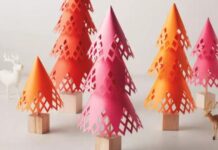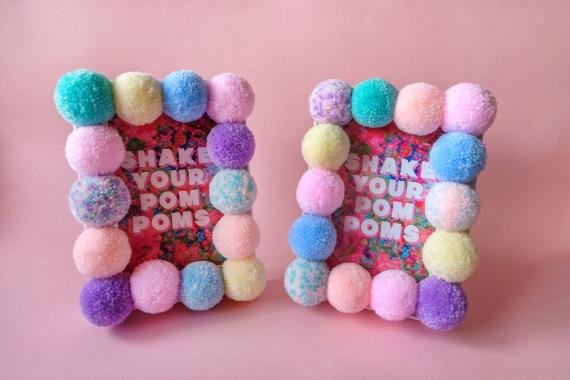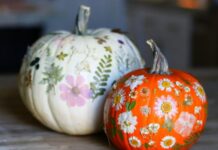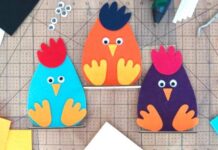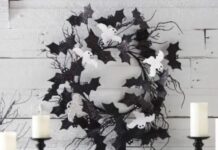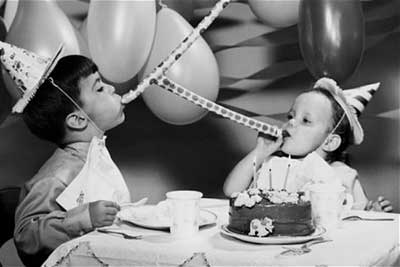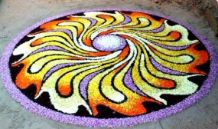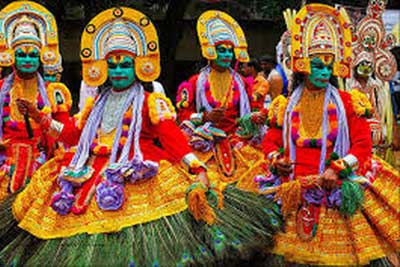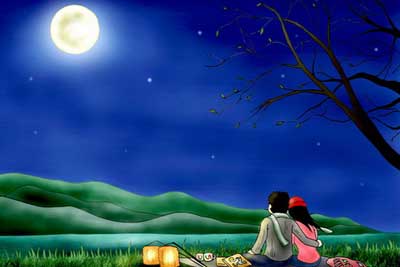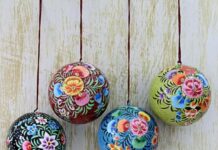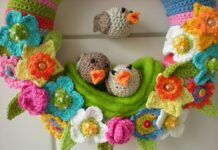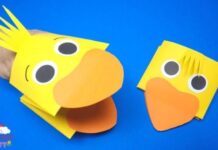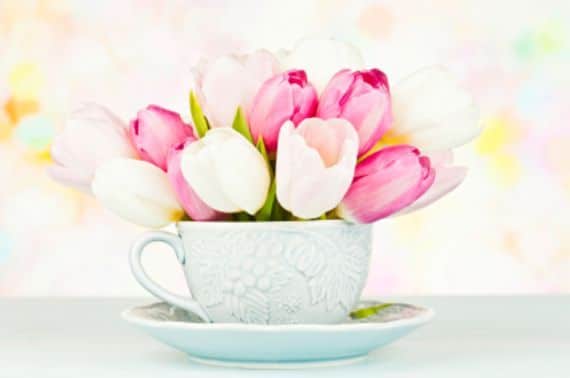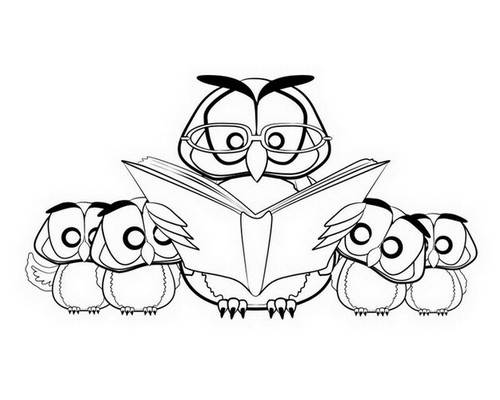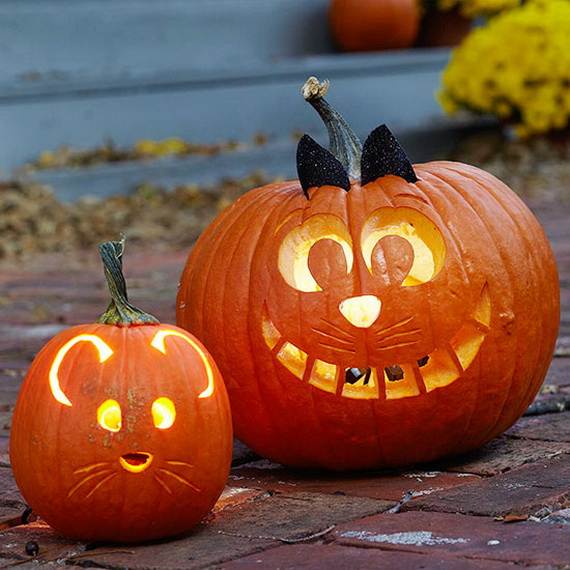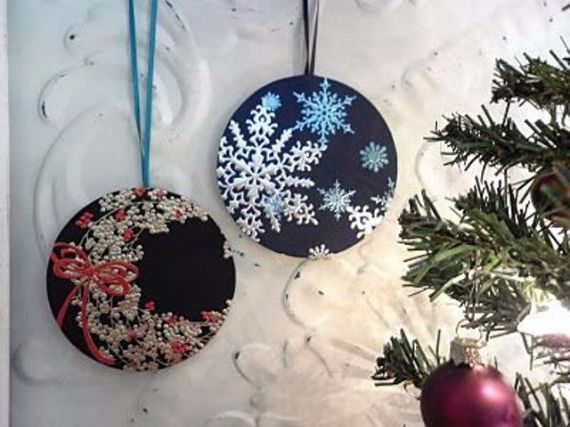Cool Small Easter Egg Crafts: Creative DIY Ideas for the Whole Family…The tradition of giving an Easter egg gift dates to centuries and it is one of the most common traditions in all civilizations. Since Easter has been considered as a religious celebration, it had its non-religious side too in nearly all parts of the world.
Even today, it has its significant occasion in every person’s life. Easter egg symbolizes are love, care, gratitude, enlightenment and a renewal of any relation, and hence it is definitely appreciated by all people no matter who or what they are. That is why Easter is the perfect time to go after your creativity with fun and easy Easter egg crafts.
Whether you’re looking for DIY Easter egg crafts to do with kids or unique Easter egg decorating techniques to impress your guests, this guide has you covered. From mini-Easter egg crafts for kids to eco-friendly Easter egg craft projects, these ideas are sure to make your holiday extra special.
Here are some craft ideas on Cool Small Easter Egg Crafts and Creative DIY Ideas for the Whole Family presented below; these cool and small Easter egg craft are unique and treasure to find.

Why Choose Cool Small Easter Egg Crafts?
Small Easter egg crafts are not only adorable but also practical. DIY Easter egg crafts can get you and your family into the spirit of the holiday to celebrate Easter in a unique way. They’re perfect for quick Easter crafts with eggs and are ideal for kids who love hands-on activities.
These fun Easter activities the whole family will love. but they also allow you to create simple Easter egg decorating techniques that stand out. They make great decorations for your Easter table or baskets. If you’re wondering how to make cool small Easter egg crafts at home, these projects are beginner-friendly and require minimal supplies.
Let’s get inspired with some of creative Easter egg designs that are easy, fun, and perfect for the whole family.

Quick and Easy Mini Easter Egg Crafts for Kids
Easter is a delightful time to engage children in creative activities that celebrate the season. Kids love getting involved in Easter crafts, and crafting mini-Easter eggs offers a fun and educational experience for kids, especially toddlers. These simple Easter egg DIY ideas are perfect for little hands, plus they are quick and easy projects not only spark creativity but also help develop fine motor skills.
These activities are designed to be safe, engaging, and suitable for young children, ensuring a joyful and creative Easter experience.
Fun Easter Egg Decorating Ideas for Toddlers
Dyeing eggs with toddlers can get messy, but with the right methods and strategies, it can be a fun and manageable activity for their little hands! Here are some ideas to create a super enjoyable and less messy egg-dyeing experience for your little ones!

Easter egg decorating with this sticker
Decorating Easter eggs with stickers is a delightful and straightforward craft that young children will enjoy. This simple activity allows them to decorate their “eggs” freely, fostering creativity and hand-eye coordination.
This Easter Egg Decorating with Stickers idea uses a sticker resist technique, similar to tape resist art. Let kids decorate eggs with colorful stickers, like dot and star. Use nature-themed stickers for a unique touch. Add intricate drawings with Sharpie markers extra fun and detail for a creative and personalized touch. Via artfulparent.

Fizzing Easter Egg Dye
Use a basic chemistry concept to dye eggs. Fizzy egg dyeing is a fun science experiment that involves combining baking soda and water to create a paste, then apply it to hard-boiled eggs. Let children drop vinegar mixed with a few drops of food coloring onto the eggs. The vinegar causes the baking soda to fizz and create a colorful display.
For each color you will mix 1 tablespoon of baking soda, 1-2 teaspoons of water, and a drop or two of food coloring in a small dish. Toddlers watching these fizzy reactions to create unique patterns is a fun science experiment. Have fun with rollercoaster.

Shaving Cream for Pretty Marbled Easter Eggs
Shaving cream Easter eggs are one of the coolest egg-decorating hacks out there! In just minutes, you can create stunning marbled Easter eggs using shaving cream and food coloring.
It’s simpler than it sounds: spray shaving cream into a shallow dish, add drops of food coloring, and gently swirl the colors together. Roll hard-boiled eggs through the mixture, let them sit, then wipe off the shaving cream to reveal beautiful marbled designs. Learn step-by-step how to dye eggs with shaving cream!

Felt Egg Decorating
Cut out egg shapes from colorful felt and provide various felt pieces, small felt shapes, and non-toxic glue. With so many options on how to decorate the eggs, toddlers can assemble and decorate their eggs, creating soft, safe, and adorable decorations perfect for little hands! Via Mariah.

Bubble Wrap Easter Egg Painting
This process art activity creates beautifully textured Easter eggs that can also be turned into cards or printed on canvas! Kids will love painting on bubble wrap, and it’s a fantastic way to reuse a recycled material.
Start by cutting bubble wrap into egg shapes—they don’t need to be perfect. Wrap a piece of bubble wrap around a rolling pin and apply washable paint to it. This method gives toddlers more space to work and helps minimize mess. Let them roll the bubble wrap over paper egg cutouts to create fun, textured, dotted patterns that look like decorated Easter eggs! Via thebestideasforkids.

Natural Dyeing with Blueberries
From red cabbage to turmeric, you can make a homemade Easter Egg dye out of tons of ingredients in your kitchen. Dye Easter Eggs with Blueberries is a natural approach to create blue robin’s eggs. Simmer blueberries in water to create a dye. Once cooled, let toddlers dip hard-boiled eggs into the blueberry dye for a beautiful, natural coloration. Via freutcake.

Fingerprint Easter Eggs
Transform plain eggs into adorable Easter creations with simple thumbprints! These fingerprint Easter eggs let you turn blank eggs into fluffy bunnies, cute chicks, and tasty carrots in just minutes. Kids will have a blast making the prints and then turning them into festive Easter animals.
To create, dip your child’s thumb in pastel paint and press it onto the egg. Once dry, use a paint pen to add details like bunny ears, eyes, and a fluffy tail. It’s an easy, fun, and creative activity for little ones! Via masandpas.

Speckled Eggs
Create stunning speckled eggs for Easter with this simple and fun technique! Start by dyeing hard-boiled eggs in solid pastel colors and letting them dry completely. Place hard-boiled eggs in a bag with uncooked rice and a few drops of food coloring. Shake until the eggs are speckled! Careful…be more gentle to not crack the shell. Via littlegreenpear.
Unique Easter Egg Decorating Techniques
Handmade Easter Egg Decorations with a Twist
Take your Easter egg crafts to the next level with these creative Easter egg designs:

Sequin Eggs
- Covering eggs (real or artificial) with sequins to create a sparkling, textured effect by using sequin pins to attach sequins to foam eggs for a glamorous look. For demonstration, you might find this link helpful.

Embroidered and Cross-Stitched Eggs:
- Cross stitching is a type of embroidery that uses a grid pattern and X-shaped stitches, where you drill small holes into blown-out eggs.
- While embroidery is using embroidery thread to create intricate designs made of variety of stitches and techniques. Via tutsplus.

Alcohol Alcohol Ink Dyed Eggs:
- From kids to adults, this is a simple and fun way to create stunning one-of-a-kind eggs spring decor with a gorgeous marble effect using alcohol ink to dye eggs. Via Allison.

Undersea Easter Eggs
- Transform your Easter eggs into a delightful collection of underwater creatures using dyed eggs, felt embellishments, and marker-drawn faces. This creative project is enjoyable for all ages and adds a unique touch to your Easter celebrations.

Mini Terrarium Eggs
- These adorable egg terrariums are a delightful and eco-friendly alternative to traditional Easter eggs. Not only are they fun to assemble, but they also make a perfect green gift!
- You can plant the entire egg directly into the soil, where it will naturally break down, adding calcium to the earth and helping to boost plant growth. Plus, the eggshells can even help deter pests like slugs and snails. Choose your favorite plants or seeds.
- Hollow out eggs and fill them with moss, tiny succulents, or faux plants for a whimsical spring display. Via thekitchykitchen.

Mosaic Shell Easter Eggs
- Creating mosaic shell Easter eggs is a delightful way to add an artistic touch to your holiday decorations. This craft involves using dyed eggshell pieces to form intricate mosaic patterns on whole eggs, resulting in a unique and colorful display. Here’s a step-by-step guide to help you create your own mosaic Easter eggsvia tutsplus.
Golden Chic
- Decorating Easter eggs with gold elements can elevate their elegance and will add sophistication and satisfy the taste of any aesthete. After dyeing your eggs, utilize metallic paint pens or gold leaf to adorn them with designs such as polka dots, stripes, or a dip-dyed effect. Instead of gold plates, you can use foil, which is used in manicure.
Fun Easter Egg Crafts for the Whole Family
Easter is a wonderful time for families to come together and engage in creative activities. These crafts offer a range of activities suitable for different age groups and skill levels, ensuring that everyone in the family can participate in the Easter fun.
Quick Easter Crafts with Eggs for All Ages
These fun Easter egg crafts are perfect for family bonding and engage in creative activities. Here are some quick and enjoyable Easter egg crafts suitable for all ages:

Donut Easter Eggs
Transform your Easter eggs into delightful donut replicas with this fun and simple DIY project. These charming donut Easter eggs are sure to be a hit at your Easter festivities, adding a sweet and creative flair to your celebrations. 🌸🐣

Floral Easter Eggs
Creating beautiful floral Easter eggs is a fuJn and creative project.these floral eggs combins two different approaches—painting real boiled eggs and decorating papier-mâché eggs.
-
If using real eggs, consider blowing out the contents before painting to preserve them longer.
-
For papier-mâché eggs, you can seal the finished design with a clear acrylic sealer to protect it.
This approach ensures your Easter eggs are beautiful, creative, and durable! 🐣🌸

Beast Eggs: Animal-Themed Easter Eggs
A fun and creative way to make Beast Eggs—Easter eggs transformed into adorable animal charactersa for a festive decoration for your home.

Unicorn eggs; A Magical Easter Craft
This enchanting idea is sure to delight everyone at home! With a touch of magic and creativity, you can easily bring these unicorn eggs to life. These unicorn eggs are a magical addition to your Easter celebrations! 🦄✨🌸

Egg cactus
A charming idea for table decor is to transform eggs into cacti and place them in miniature terracotta pots. Crafting a flower from colored tissue paper is simple: take a small piece and pinch it with your fingers to form the blossom.
For the cactus spines, use a fine-tip marker to draw them onto the egg’s surface. This creative project adds a delightful touch to your table setting.

Decorative Easter Eggs Gifts
Transform Easter eggs into beautiful, personalized gifts that your friends and family will cherish! These decorative eggs can be filled with treats, used as ornaments, or displayed as festive decor. Via burdastyle.🐣🌸🎁

Ice Cream Painted Eggs
Turn your Easter eggs into adorable ice cream cone masterpieces! This creative and playful idea is perfect for kids and adults alike. via minibhu.
To display your ice cream eggs… place your ice cream eggs in a decorative basket or on a platter. Arrange them with Easter grass or shredded paper to mimic a festive ice cream stand. Use them as table decorations or give them as sweet Easter gifts.
Eco-Friendly Easter Egg Craft Projects
Easter is a time for creativity, joy, and celebration, but it’s also an opportunity to embrace eco-friendly practices. Instead of relying on plastic or store-bought decorations, why not create beautiful Easter egg crafts using sustainable materials?
These projects are not only kind to the planet but also allow you to explore your creativity while reducing waste. From natural dyes to upcycled materials, eco-friendly Easter egg crafts are perfect for families, classrooms, or anyone looking to celebrate the season in a greener way.
Let’s dive into some fun and sustainable ideas that will make your Easter both festive and environmentally conscious! 🌍🐣🌸
Sustainable and Creative Ideas
If you’re looking for eco-friendly Easter egg craft projects, try these ideas:

DIY Moss Easter Eggs: A Natural and Earth-Friendly Craft
Bring a touch of nature to your Easter celebrations with these charming DIY Moss Easter Eggs! Perfect for adding a rustic, eco-friendly vibe to your decor, these eggs are easy to make and require minimal materials. Whether you’re crafting with kids or looking for a unique centerpiece idea, moss-covered eggs are a delightful way to celebrate the season. Via chatfieldcourt.

Fabric-Wrapped Eggs
Add a touch of elegance and texture to your Easter decor with fabric-wrapped eggs! This simple yet stunning craft is perfect for using up fabric scraps or repurposing old clothing. With some creative Variations to add a handmade touch to your Easter celebrations;
- Patterned Fabric: Use floral, polka dot, or striped fabric for a playful look.
- Monochromatic Style: Stick to one color or fabric type for a cohesive, elegant design.
- Patchwork Eggs: Mix and match different fabrics for a quirky, eclectic vibe.
- Embroidered Details: Add hand-stitched designs or embroidery to the fabric before wrapping.
Learn how to make beautiful, one-of-a-kind home decor pieces using fabric via craftidly.🌍🐣🌸

Seed Paper Eggs
Celebrate Easter and the arrival of spring with seed paper eggs—a creative, eco-friendly craft that keeps on giving! These unique eggs are made from biodegradable seed paper, which can be planted to grow flowers, herbs, or vegetables. They’re perfect for gifting, decorating, or as a fun activity for kids. Via handmadecharlotte.

Creative DIY Easter Egg Designs Using Natural Dyes
Explore the beauty of Easter egg designs using natural dyes with these creative DIY Easter egg designs! Using ingredients from your kitchen, you can create stunning, eco-friendly eggs in a variety of soft, earthy tones.
Eco-Friendly Easter Egg Craft Projects
For those who prefer eco-friendly Easter egg craft projects, natural dyes are a great option. Natural dyes offer a beautiful range of colors for dyeing eggs, all derived from everyday kitchen ingredients. Here’s a breakdown of the colors you can achieve and the natural materials to use…For demonstration, you might find this link helpful. Here’s how to make them:
Ingredients for Natural Dyes:

How to Make Yellow Easter Eggs with Natural Dye
Turmeric (bright yellow); Using turmeric to create bright yellow Easter eggs is a simple, natural, and vibrant way to decorate for the season! For demonstration, you might find this link helpful.

How to Make Orange Easter Eggs with Natural Dye
Yellow onion skins (deeper orange); Create stunning botanical Easter art by dyeing eggs with onion skins and using flowers and herbs as natural stencils. This method combines the beauty of homemade Easter eggs with the creativity and nostalgia of traditional crafting.
By wrapping eggs in onion skins and nylon stockings, you’ll achieve unique, one-of-a-kind designs—no two eggs will ever be the same! For demonstration, you might find this link helpful.
Paprika (warm orange); Paprika, a spice derived from dried peppers, offers a beautiful orange tint ideal for Dyed Easter Eggs purpose.
How to Make Pink/Red Easter Eggs with Natural Dye

Beets (soft pink to light red); Beets impart a beautiful reddish-pink hue to the eggs, offering a natural alternative to synthetic dyes.

Cranberries (pale pink); By using cranberries to dye your Easter eggs, you not only achieve beautiful, natural colors but also engage in an eco-friendly crafting activity.
To create unique designs on Easter eggs, consider wrapping them with rubber bands or placing leaves and flowers against the shell before dyeing. This technique allows for creative patterns and adds a natural touch to your decorated eggs.

Raspberries (light pink); Using raspberries to naturally dye Easter eggs is a great way to achieve soft, pastel pink hues. The soft pink color is perfect for spring, and the process is simple and fun for all ages!
How to Make Blue/Purple Easter Eggs with Natural Dye
Creating a blue/purple natural dye for eggs can be achieved using ingredients like red cabbage, blueberries, and Purple grape juice which yields a range of blue and purple hues depending on the pH level of the dye bath.

Red cabbage (blue or lavender); Dyeing Easter eggs with red cabbage is a delightful and natural way to achieve stunning blue hues. Using red cabbage to naturally dye Easter eggs is a fascinating process because it can produce a range of colors, from soft blue to lavender or even pink, depending on the pH level of the dye bath.
Red cabbage contains a natural pigment called anthocyanin, which reacts to acidity or alkalinity. (Red cabbage is the same thing as purple cabbage). For demonstration, you might find this link helpful.
Blueberries (soft purple); Natural blueberry-dyed Easter eggs are created by simmering blueberries in water to extract their vibrant color, which is then used to dye the eggs. Using fresh blueberries typically results in a soft, pastel blue hue, while reducing the blueberry juice by boiling it longer yields a richer, deeper shade with hints of purple.
This simple, natural method is a beautiful way to add a touch of creativity to your Easter celebrations! 🥚💜For demonstration, you might find this link helpful.
Purple grape juice (light purple); Using purple grape juice is an effective and natural method to dye Easter eggs, resulting in shades ranging from lavender to deep purple.
Blackberries; gives Purple to gray color.
Purple Carrots; Light purple. you have to soak eggs in the dye for 30 minutes to several hours.
Elderberries: gives deep purple when soaking eggs in the dye for 30 minutes.
Purple Basil or Purple Kale: Light purple, when soaking eggs in the dye for 30 minutes to several hours.
Hibiscus Flowers (Dried) : Purple to magenta.
Purple Sweet Potatoes: Light purple.
Concord Grapes: Purple.
Butterfly Pea Flowers (Dried): Vibrant blue (can turn purple with added acid like lemon juice or vinegar).

How to Make Green Easter Eggs with Natural Dye
Natural dyeing is an art, and the results can vary depending on factors like soaking time, the type of egg used, and the concentration of the dye. Among all the colors, achieving the perfect green dye is the most challenging.
This method is to mix turmeric and red cabbage leaf dyes (using 2 cups of shredded red cabbage and 1 tablespoon of ground turmeric), though using matcha tea is a close second. While spinach can produce a more earthy tone, this color might appeal to those who prefer muted, natural hues.
Spinach (light green) ; Spinach is known for its green pigment and can be used to dye eggs.
Red Cabbage and Turmeric Combination; A combination of red cabbage and turmeric dyes can produce green hues on eggs.
Matcha powder (vibrant green); On the yellow side, like the chartreuse colour it produces.
Parsley (soft green); Parsley can also be used to create a green dye for eggs.
Kale; Kale produces a yellow-green shade, but it requires soaking overnight to achieve the depth of color you desire. Even when tring using more kale the second time, the process still felt too time-consuming.
Zucchini Skins; The most commonly suggested green options were spinach or grass. However, since green grass isn’t available during Easter in many places, try to use kale and zucchini skins as alternatives to achieve a better green. While these methods might be your interest, the combining turmeric and red cabbage dyes gave the most satisfying results.

How to Make Brown Easter Eggs with Natural Dye
Creating natural brown dyes is a rewarding process that utilizes various plant-based materials. These dyes can be used for coloring fabrics, Easter eggs, and other crafts.
Coffee (rich brown); using this method is effective for achieving a range of brown shades, depending on the soaking time.
Black tea (warm tan or brown); Tea can impart a warm, brown tone to eggs depending on the soaking time.
Brown onion skins (earthy brown); Onion skins are a popular natural dye source, capable of producing a range of colors from yellow to deep brown, depending on the type of onion and the dyeing process used. Yellow onion skins typically yield shades of yellow, orange, rust, and brown on fibers.
Walnut Hull-Based Brown Dye; Walnut hulls are known for producing a rich, deep brown dye.
Oak Bark or Acorn-Based Brown Dye; Oak-derived dyes offer a range of brown tones, depending on the concentration and soaking time.
Steps to Dye Eggs Naturally:
- Boil your chosen ingredient in water for 15-20 minutes (The longer the mixtures cook, the stronger the dyes will be).
- Strain the liquid and add 1-2 tablespoons of vinegar.
- Soak the eggs in the dye until they reach the desired color.
- Let them dry and display your beautiful, naturally dyed eggs.
Tips for Best Results:
- Use white eggs for the most vibrant colors.
- Add 1-2 tablespoons of white vinegar to the dye to help the color adhere.
- Let the eggs soak in the dye for several hours or overnight for deeper shades.
- Experiment with layering dyes (e.g., blue + yellow = green) for unique colors!
Natural dyes create soft, earthy tones that are perfect for a rustic, eco-friendly Easter celebration!
The Problem with Artificial Food Dyes
Artificial food dyes are prevalent in the United States, primarily because they are an inexpensive way to make food more visually appealing. However, these synthetic additives have been linked to various health concerns, especially behavioral issues in children. Studies have indicated that certain dyes can exacerbate hyperactivity and inattention in sensitive children.
For those seeking safer alternatives, natural food dyes offer a compelling solution. Ingredients like beets, spinach, pumpkin, berries, cabbage, and turmeric can provide a range of colors without the associated health risks of synthetic dyes. While these natural options may not always achieve the same intensity as artificial colors, they allow consumers to enjoy visually appealing foods without compromising health.
Make This Easter Unforgettable with Cool Small Easter Egg Crafts
From quick and easy mini Easter egg crafts for kids to creative DIY Easter egg designs using natural dyes, these ideas are perfect for celebrating the holiday in style. Whether you’re crafting with toddlers or trying out unique Easter egg decorating techniques, these projects are sure to bring joy and creativity to your Easter festivities.
So, gather your supplies, invite the family, and start creating your cool small Easter egg crafts today! Happy crafting and Happy Easter! 🐰🌸

